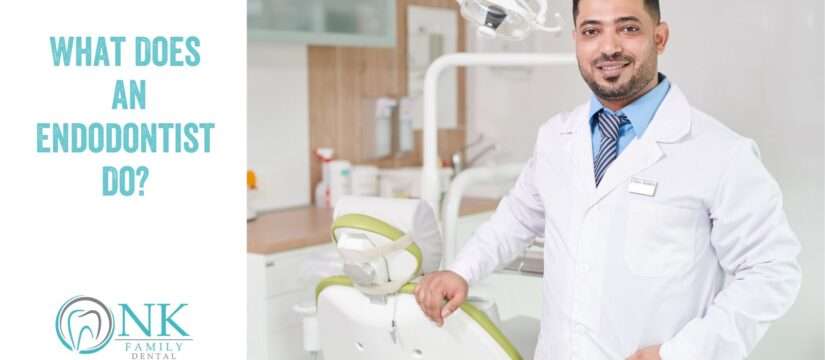
Most people are familiar with the services a dentist provides. And even those who’ve never had orthodontic treatment know what an orthodontist does. But what does an endodontist do? Even if you’ve undergone root canal treatment — the procedure by which endodontists are typically associated with — there’s much more to this specialized branch of dentistry to learn about!
First, What is Endodontics?
Simply put, endodontics is the branch of dentistry concerning dental pulp and tissues surrounding the roots of a tooth. “Endo” is the Greek word for “inside” and “odont” is Greek for “tooth.” Now that you know the origin of the word itself, you can impress your friends!
More to the point, endodontics is the field of dentistry that focuses on the health of the teeth from the inside. Teeth are composed of four dental tissues. Three of them — enamel, dentin, and cementum —are hard tissues. The fourth tissue — pulp — is found in the center of the tooth. Pulp is a soft, or non-calcified, tissue that contains nerves, blood vessels and connective tissue. Basically, pulp is what keeps the tooth alive — or to use the medical term — viable. Endodontics includes a variety of procedures that treat the dental pulp to restore or preserve the health of the teeth.
For more information about dental tissues and tooth structure, our blog post — “Tooth Anatomy 101” — covers this topic in detail.
What are the Differences Between an Endodontist and a Dentist?
After completing dental school and earning their doctor of medicine in dentistry or doctor of dental surgery, additional training is required in the field of endodontics. Endodontists must complete an additional two to three years in an advanced endodontic residency program to be qualified to practice. This additional training focuses on diagnosing tooth pain and root canal treatment, and other procedures relating to the interior of the tooth. While all endodontists are dentists, less than three percent of dentists are endodontists.
Moreover, by limiting their practice to endodontics, endodontists focus exclusively on treatments of the dental pulp. According to the American Association of Endodontists (AAE), they complete an average of 25 root canal treatments a week, while general dentists typically do two. “Endodontists don’t place fillings or clean teeth — they dedicate their time to diagnosing and treating tooth pain. They are skilled specialists in finding the cause of oral and facial pain that has been difficult to diagnose.”
Procedures an Endodontist Performs
For those familiar with endodontics, a root canal immediately comes to mind. However, there are several other procedures that an endodontist performs in addition to root canals.
Root canal therapy — This is perhaps the best-known procedure that an endodontist performs. A tooth develops a root canal infection — also known as irreversible pulpitis — when decay spreads to the pulp, or when a bacterial infection develops inside the tooth or at its root tip. It must then be removed from the canal in order to stop dental pain and prevent infection from spreading throughout the body — which can lead to sepsis, a life-threatening medical emergency.
The AAE explains root canal treatment as follows:
“Root canal treatment is designed to eliminate bacteria from the infected root canal, prevent reinfection of the tooth and save the natural tooth. When one undergoes a root canal, the inflamed or infected pulp is removed and the inside of the tooth is carefully cleaned and disinfected, then filled and sealed.”
Unlike the root canal process common years ago, today’s procedure is typically performed in a single visit, with no discomfort. Our blog post — “What You Need to Know About a Root Canal” — covers this procedure and its advancements in detail.
After root canal treatment, the tooth structure remains intact, but without its pulp the tooth is no longer “alive” so to speak. This eventually makes it brittle and fragile, which is why the final step is for a dentist to place a crown over the tooth. The restoration gives the tooth strength and protection so it functions just as before. Crowning also provides an aesthetic benefit, as the tooth may become discolored. Our blog post — “What You Need to Know About Crowns” — covers the functions of dental crowns in detail.
Endodontic retreatment — This is a dental procedure in which a tooth that has previously undergone root canal therapy is reopened to address persistent issues like infection, pain, or incomplete healing. It essentially provides a second chance to save the tooth by re-cleaning and re-filling the root canals.
Apicoectomy — An apicoectomy — also known as a surgical root-end resection — is a follow-up if infection persists or recurs at the tip of the tooth’s root after a conventional root canal treatment. In this procedure, the root tip and surrounding infected tissue is removed. A small filling may be placed to seal the end of the root canal, preventing future infection. The site is then sutured to promote healing, allowing the bone to naturally heal around the root.
Root amputation — Not to be mistaken for an apicoectomy, a root amputation is the surgical removal of one root from a multi-rooted tooth. It is generally performed on the upper molars because they have three roots. This microsurgery procedure is performed to eliminate infection or prevent further bone loss in an area where infection or tooth fracture has caused it. West Fort Worth Endodontics describes it as “… a tactical strike to preserve the integrity of the rest of the tooth and surrounding teeth.” Not every tooth is a candidate for this delicate procedure, but when it can be performed, it’s often pivotal in saving part of a damaged tooth.
Cracked tooth treatment — A tooth can crack for many reasons, ranging from biting down on ice/hard food, using your teeth as a tool, or trauma. The sooner a cracked tooth is diagnosed, the more likely it is to be saved. There are three main types of cracks:
- Superficial cracks — Minor cracks in the enamel can often be treated with dental bonding, fillings, or crowns.
- Cracks involving the pulp — If the crack extends to the pulp, a root canal may be necessary to remove the damaged pulp and prevent infection.
- Vertical root fractures — In some cases, even with vertical root fractures (cracks extending from the root upwards), endodontic surgery might be an option if a portion of the tooth can be saved by removing the fractured root.
While not all cracked teeth can be saved, endodontists have the expertise and tools to preserve many teeth that might otherwise be lost.
The Take-Home Message
Endodontists are dental specialists focused on treating conditions related to the dental pulp and the tissues surrounding the tooth’s root. They are experts in diagnosing and treating pain and infections within the tooth’s interior, allowing the tooth to be saved, rather than extracted.
Whatever endodontic procedure may be necessary for you, today’s advanced treatments are painless and convenient. When performed at NK Family Dental, you’ll experience treatment by our outstanding endodontist, Dr. Sabek.
Dr. Sabek received his Doctor of Dental Medicine from the University of Pittsburgh. In 2004, Dr. Sabek earned his endodontist specialty from the State University of New York at Buffalo, where he soon also received a Master of Science degree in endodontics. He specializes in painless endodontic and root canal treatments that generally require just one single visit for treatment. Dr. Sabek is also committed to using the latest equipment and technology to provide excellent quality care with the highest priority on patient comfort and satisfaction.
It is our mission to provide the highest quality and most compassionate oral care to our Chicago patients, including both dental and periodontal services. Our practice is trusted for advanced oral surgery procedures and — of course — comfortable root canal treatment. Our spa-like office provides an atmosphere that is modern, tranquil and inviting, designed for the ultimate in comfort.
Our team of experienced, dedicated dental professionals will help address your oral health concerns, and determine the best solution for you based on your individual situation. We strive to identify treatment options that fit your needs. In addition to Dr. Sabek, our dental specialists include our general dentist, Dr. Nilofer Khan and our periodontist, Dr. Amir Danesh. Dr. Danesh is a board-certified periodontist and Diplomat of the American Board of Periodontology. He has contributed to the publication of two books, as well as published over 20 papers in prestigious dental research journals.
We serve the neighborhoods of Logan Square, Bucktown, Humboldt Park, and Wicker Park with the dedication that’s earned us the reputation as the Best Dentist in Chicago!
We understand that the main concern you may have is cost, which is why we accept all major PPO plans for dental insurance and also offer our in-house dental plan. Please see our financing page for more information.
Schedule your visit through ZocDoc, or contact us directly. We look forward to treating you soon!
